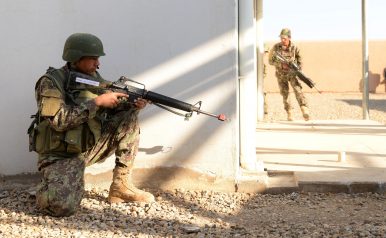By Catherine Putz
 In late December, China’s hosting of a trilateral meeting with the foreign ministers of Afghanistan and Pakistan drew headlines. “China Steps Up to Broker Peace in Afghan-Pakistan Conflict,” Bloomberg reported; “China can help bring peace to Afghanistan,” the South China Morning Post declared. Reuters highlighted China’s announcement that Afghanistan would be included into the China-Pakistan Economic Corridor (CPEC). Fewer took note of the subsequent meeting between Chinese State Councilor and Defense Minister Chang Wanquan and Afghan Minister of Defense Tariq Shah Bahrami. Bahrami also met with the Vice Chairman of China’s Central Military Commission Xu Qilian. The Diplomat’s Ankit Panda covered the meeting, noting that it “underlined the increasingly close military-to-military ties between the two countries.”
In late December, China’s hosting of a trilateral meeting with the foreign ministers of Afghanistan and Pakistan drew headlines. “China Steps Up to Broker Peace in Afghan-Pakistan Conflict,” Bloomberg reported; “China can help bring peace to Afghanistan,” the South China Morning Post declared. Reuters highlighted China’s announcement that Afghanistan would be included into the China-Pakistan Economic Corridor (CPEC). Fewer took note of the subsequent meeting between Chinese State Councilor and Defense Minister Chang Wanquan and Afghan Minister of Defense Tariq Shah Bahrami. Bahrami also met with the Vice Chairman of China’s Central Military Commission Xu Qilian. The Diplomat’s Ankit Panda covered the meeting, noting that it “underlined the increasingly close military-to-military ties between the two countries.”
Those military-to-military ties are set to grow even closer. On Thursday, Fergana News, a Russian news outlet covering Central Asia, reported that a new Afghan military base would be built in Badakhshan with Chinese funding.Enjoying this article? Click here to subscribe for full access. Just $5 a month.
Badakhshan is one of Afghanistan’s northern provinces. The Wakhan Corridor is the province’s thin strip of land — often called a panhandle — that winds through the mountains between Tajikistan, to the north, and Pakistan, to the south. At its extremity, Badakhshan borders China’s Xinjiang.
According to Fergana, General Dawlat Waziri, a spokesman for the Afghan Ministry of Defense, said that the Chinese would cover “all material and technical expenses for this base — weaponry, uniforms for soldiers, military equipment and everything else necessary for its functioning.”
Another source from the Afghan Defense Ministry indicated to Fergana that Beijing’s motivation was the involvement of Uyghur fighters in the Islamic State affiliate operating in Afghanistan.
Badakhshan is viewed by some as strategic and has proven problematic. During Taliban rule, it remained one of the few regions out of reach. Pakistan’s 2014 movement against militants in north Waziristan pushed some back into Afghanistan. As an RFE/RL analysis from 2015 notes, some may have fled into Badakhshan, though the route is not simple: either crossing through Afghanistan or via Pakistan’s Chitral. In April 2015, 18 Afghan soldiers were killed — eight of them beheaded — when their outpost in Jurm district in Badakhshan was attacked by the Taliban. In June 2016, Ali M. Latifi and Mohsin Khan Mohmand reported for the LA Times that a high-level aid to President Ashraf Ghani said he had seen “evidence of small Islamic State-affiliated contingents as far as Kunduz and Badakhshan provinces…”
Chinese motivation being Uyghur militants in the Islamic State is a claim that is difficult to verify, as is the reality of the Islamic State’s presence in Badakhshan.
Chinese funding of an Afghan military base in Badakhshan could arguably be seen as part of ensuring regional stability around its projects in Pakistan. If the Chinese are as involved as Waziri suggests, we can expect rumors of actual Chinese military involvement in the region to spike again. Beijing has been cautious to not become militarily involved in conflicts outside its borders, but as China’s interests grow and expand into insecure places, the leadership in Beijing run the risk of being pulled in, even unwillingly.
Update: This article was updated substantially after comments from Franz J. Marty, who pointed out a few errors of geography and logic. It is important to note that this article is based on one report on a subject that has long been the subject of rumors. My aim was to discuss Chinese logic for such a project.
No comments:
Post a Comment